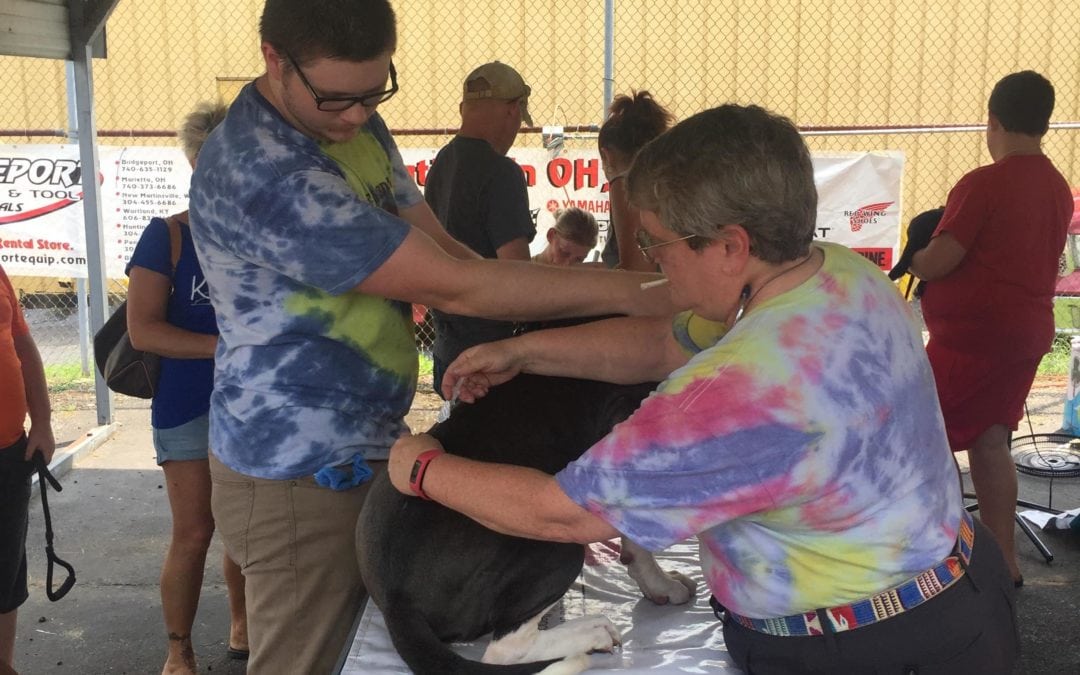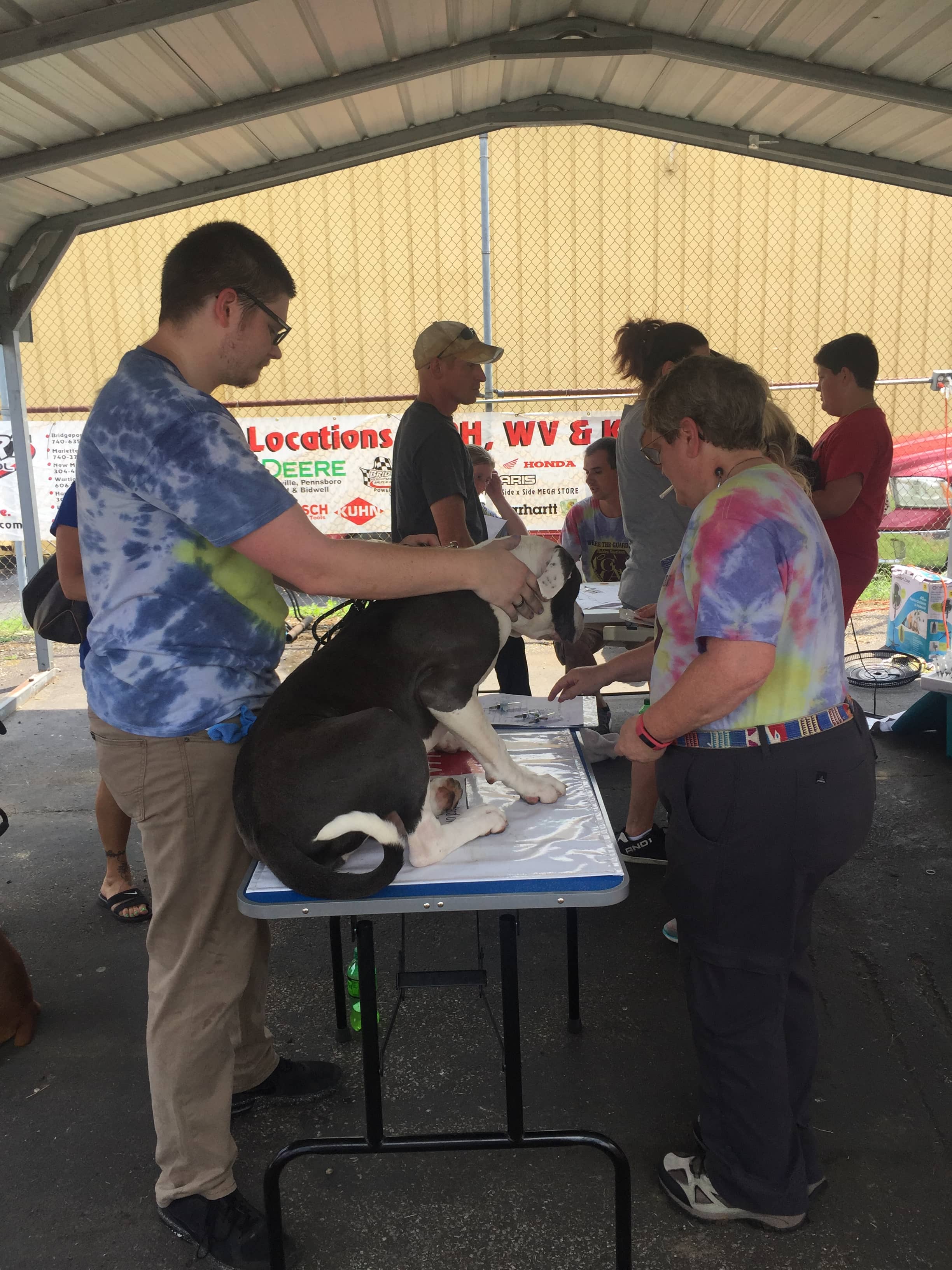Last week, Matt drove me to Charleston to get a yellow fever vaccination. I need a booster vaccine, because this fall, I am going to northern Uganda in Africa to vaccinate and neuter village dogs, and yellow fever is one of the vaccines that I needed to get updated. In a somewhat related story, today I vaccinated 56 dogs at Raceland Race Days vaccine clinic.
Regardless of the species, we generally vaccinate for two reasons. The first is to protect the individual by giving the individual immunity. Sometimes, in humans, it is lifelong protection. Sometimes, like many dog and cat diseases, vaccinations need boosters. Dogs are vaccinated for distemper, hepatitis, adenovirus, parvovirus and sometimes leptospirosis, Lyme and influenza.
Children are vaccinated for measles, chicken pox, pneumococcal disease, and other illnesses. Older children get vaccines to protect them from diseases that affect adolescents and adults. Travelers get vaccinated for diseases they may encounter during travel to other regions which is why I have to have a yellow fever vaccination booster. Dogs, cats, ferrets, and birds get vaccines to protect them from the things they catch.
I had a yellow fever vaccination in the military along with several other vaccines. They wanted to be able to deploy us anywhere in the world at a moment’s notice. So soon after reporting in, they lined us up. We took a step. There was a medical corpsman on our right and the left. Each corpsman had a syringe gun in their hand. We got an injection in each shoulder, took another step with two more injections and then a third. Six vaccinations in less than a minute. If you dropped (some of the guys did), they held you up and passed you to the next corpsman pair for your next vaccines. At the end of the vaccine line, they laid the passed out cadets on the floor to wake up on their own.
Although the yellow fever vaccine probably conveys lifelong immunity, the Department of Health and Human Services Center for Disease Control and Prevention (CDC) only recognizes it for ten years. The Tdap or Td with tetanus, diphtheria, and pertussis is also boostered every ten years, but you get that boosted when you get a cat or dog bite or step on a rusty nail. Some of the vaccines, I got boostered before I left the Coast Guard Academy, some would be boostered later in my life. Yellow fever, not until now.
In England, when MMR (measles, mumps, and rubella) vaccination rates dropped the cases of disease dramatically increased. Although measles is extremely infectious there were only 56 confirmed cases in Great Brittan in 1998. However, when vaccine rates declined, there were 1348 cases in 2008. Vaccines had prevented disease until they were not used. Now measles are much more common because of anti-vaccers. Likewise, there are areas of the U.S. that do not have parvo or distemper. Unfortunately, we see far too much of both of those diseases.
The secondary benefit of vaccination is herd immunity or community immunity in humans. This means that enough people (or dogs) get vaccinated to stop the spread of the disease. A high herd immunity will protect even the people who do not get vaccinations. When enough people are immunized against a given disease, it’s difficult for the disease to have an outbreak. This means even the people who are unable to receive vaccinations (think newborns and immune-compromised people) are likely not to be exposed by an outbreak. This also protects individuals who got vaccinated but didn’t mount a good immune response. (Because nothing is 100% effective.)
There are valid medical reasons for some people to not get some vaccines. I did not need a yellow fever vaccine until I was going to be at risk for yellow fever again. I am allergic to flu vaccinations, so I avoid those and rely on herd immunity and my immune system to protect me.
When we vaccinate for rabies in dogs, cats, and ferrets, we are using herd immunity to protect humans. If enough pets get vaccinated, the disease is less likely to have an outbreak and cause human cases of rabies. Wildlife are vaccinated by airdrops of oral vaccine to help prevent the spread also. Because of dog and cat vaccines, human rabies cases are rare every year in the United States. This is not the case in other parts of the world. Because dogs and cats are not vaccinated, one person dies every nine minutes from rabies. That is why I will be traveling to African villages to vaccinate dogs to help people live. And I did a titer to check to make sure that my rabies vaccine was still working. Although I was bitten by a rabid animal in 1995 and 2013 and got two boosters both times. (I also got my rabies vaccines while in the Coast Guard, but that was because I had been admitted to veterinary medical school and didn’t want to pay the $1000 for the vaccine series.)
When we held our vaccine clinic today, there was not a choice for basic vaccines. Dogs received distemper, hepatitis, parainfluenza, parvovirus, leptospirosis, Bordetella, and rabies. (Lyme and influenza were optional.) The rabies is for human disease, but the others protect the individual dogs. Anyone of those diseases can be fatal and if the dog gets the disease, they will pass it to any other unvaccinated dog that comes in contact with the virus. Dogs that needed special vaccines or care needed to be seen at a veterinary hospital, not a clinic.
I have to wait a month between vaccinations and will only have to go to Huntington for those. But when I get my cholera, Hepatitis B, meningitis and typhoid vaccines, I am protecting myself. But I am protecting my community when I get my yellow fever vaccine before I go. My rabies vaccine is just plain good sense given my life passion.





